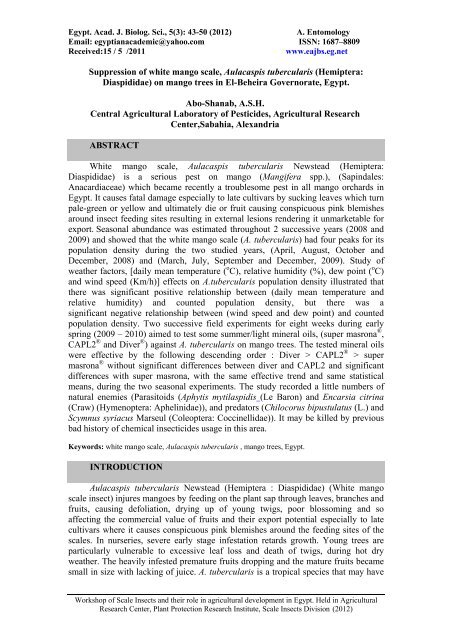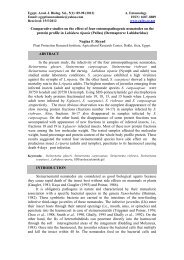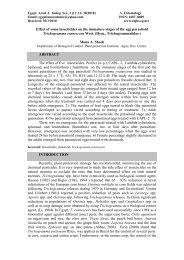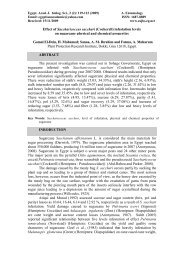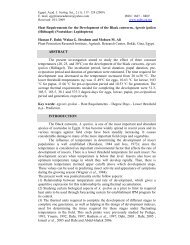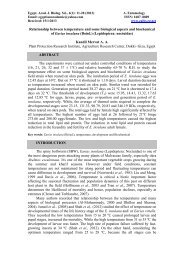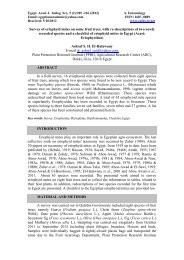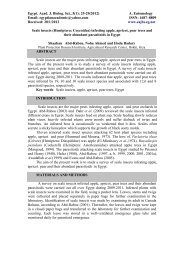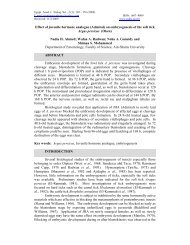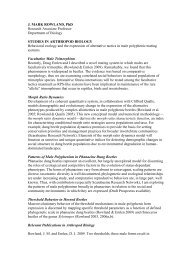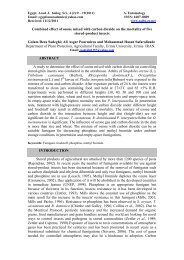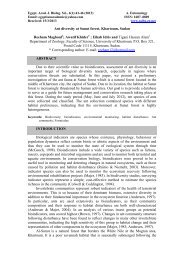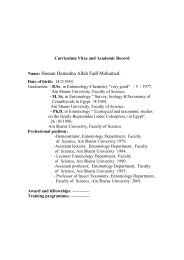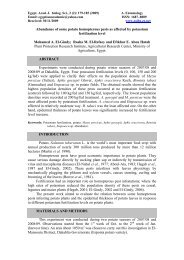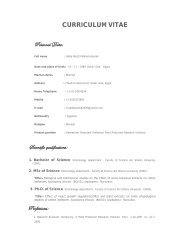Suppression of white mango scale, Aulacaspis tubercularis ...
Suppression of white mango scale, Aulacaspis tubercularis ...
Suppression of white mango scale, Aulacaspis tubercularis ...
Create successful ePaper yourself
Turn your PDF publications into a flip-book with our unique Google optimized e-Paper software.
Egypt. Acad. J. Biolog. Sci., 5(3): 43-50 (2012) A. Entomology<br />
Email: egyptianacademic@yahoo.com ISSN: 1687–8809<br />
Received:15 / 5 /2011 www.eajbs.eg.net<br />
<strong>Suppression</strong> <strong>of</strong> <strong>white</strong> <strong>mango</strong> <strong>scale</strong>, <strong>Aulacaspis</strong> <strong>tubercularis</strong> (Hemiptera:<br />
Diaspididae) on <strong>mango</strong> trees in El-Beheira Governorate, Egypt.<br />
Abo-Shanab, A.S.H.<br />
Central Agricultural Laboratory <strong>of</strong> Pesticides, Agricultural Research<br />
Center,Sabahia, Alexandria<br />
ABSTRACT<br />
White <strong>mango</strong> <strong>scale</strong>, <strong>Aulacaspis</strong> <strong>tubercularis</strong> Newstead (Hemiptera:<br />
Diaspididae) is a serious pest on <strong>mango</strong> (Mangifera spp.), (Sapindales:<br />
Anacardiaceae) which became recently a troublesome pest in all <strong>mango</strong> orchards in<br />
Egypt. It causes fatal damage especially to late cultivars by sucking leaves which turn<br />
pale-green or yellow and ultimately die or fruit causing conspicuous pink blemishes<br />
around insect feeding sites resulting in external lesions rendering it unmarketable for<br />
export. Seasonal abundance was estimated throughout 2 successive years (2008 and<br />
2009) and showed that the <strong>white</strong> <strong>mango</strong> <strong>scale</strong> (A. <strong>tubercularis</strong>) had four peaks for its<br />
population density during the two studied years, (April, August, October and<br />
December, 2008) and (March, July, September and December, 2009). Study <strong>of</strong><br />
weather factors, [daily mean temperature ( o C), relative humidity (%), dew point ( o C)<br />
and wind speed (Km/h)] effects on A.<strong>tubercularis</strong> population density illustrated that<br />
there was significant positive relationship between<br />
(daily mean temperature and<br />
relative humidity) and counted population density, but there was a<br />
significant negative relationship between (wind speed and dew point) and counted<br />
population density. Two successive field experiments for eight weeks during early<br />
spring (2009 – 2010) aimed to test some summer/light mineral oils, (super masrona ® ,<br />
CAPL2 ® and Diver ® ) against A. <strong>tubercularis</strong> on <strong>mango</strong> trees. The tested mineral oils<br />
were effective by the following descending order : Diver > CAPL2 ® > super<br />
masrona ® without significant differences between diver and CAPL2 and significant<br />
differences with super masrona, with the same effective trend and same statistical<br />
means, during the two seasonal experiments. The study recorded a little numbers <strong>of</strong><br />
natural enemies (Parasitoids (Aphytis mytilaspidis (Le Baron) and Encarsia citrina<br />
(Craw) (Hymenoptera: Aphelinidae)), and predators (Chilocorus bipustulatus (L.) and<br />
Scymnus syriacus Marseul (Coleoptera: Coccinellidae)). It may be killed by previous<br />
bad history <strong>of</strong> chemical insecticides usage in this area.<br />
Keywords: <strong>white</strong> <strong>mango</strong> <strong>scale</strong>, <strong>Aulacaspis</strong> <strong>tubercularis</strong> , <strong>mango</strong> trees, Egypt.<br />
INTRODUCTION<br />
<strong>Aulacaspis</strong> <strong>tubercularis</strong> Newstead (Hemiptera : Diaspididae) (White <strong>mango</strong><br />
<strong>scale</strong> insect) injures <strong>mango</strong>es by feeding on the plant sap through leaves, branches and<br />
fruits, causing defoliation, drying up <strong>of</strong> young twigs, poor blossoming and so<br />
affecting the commercial value <strong>of</strong> fruits and their export potential especially to late<br />
cultivars where it causes conspicuous pink blemishes around the feeding sites <strong>of</strong> the<br />
<strong>scale</strong>s. In nurseries, severe early stage infestation retards growth. Young trees are<br />
particularly vulnerable to excessive leaf loss and death <strong>of</strong> twigs, during hot dry<br />
weather. The heavily infested premature fruits dropping and the mature fruits became<br />
small in size with lacking <strong>of</strong> juice. A. <strong>tubercularis</strong> is a tropical species that may have<br />
Workshop <strong>of</strong> Scale Insects and their role in agricultural development in Egypt. Held in Agricultural<br />
Research Center, Plant Protection Research Institute, Scale Insects Division (2012)
44<br />
Abo-Shanab, A.S.H.<br />
originated in Asia. It has been recorded mainly from hosts belonging to four plant<br />
families : Palmae, Lauraceae, Rutaceae, Anacardiaceae, particularly on <strong>mango</strong>es and<br />
cinnamon (Borchsenius, 1966).<br />
Its population densities were recorded on <strong>mango</strong>es in few parts <strong>of</strong> the world<br />
(Annecke, 1963; Almeida, 1972 and Labuschange et al., 1995). It has been spread by<br />
the transport <strong>of</strong> infested plant material and is now widespread in many <strong>mango</strong>growing<br />
countries. It presents as a significant pest problems on <strong>mango</strong>es in South<br />
Africa (Colyn and Schaffer, 1993; Joubert et al. 2000a), in Australia, East and West<br />
Africa, North and South America and the Caribbean Islands (Peña et al., 1997). It has<br />
not been recorded from most <strong>of</strong> the tropical Pacific islands. (Tao, 1999; Porcelli,<br />
1990; Longo et al., 1995; International Institute <strong>of</strong> Entomology (IIE), 1993 and<br />
Danzig, and Pellizzari, 1998). This insect became an economic pest all over Egypt,<br />
after it was restricted in Minia Governorate under quarantine regulations then crept to<br />
Beni-Suif Governorate, so population fluctuations and role <strong>of</strong> its natural enemies in<br />
regulating its abundance have not wide studied till now in Egypt, (Morsi, et al. 2002).<br />
The role <strong>of</strong> <strong>white</strong> <strong>mango</strong> <strong>scale</strong> insect natural enemies in regulating its abundance was<br />
discussed by some authors (Quednau, 1964; Viljoen, 1986; Schoeman, 1987;<br />
Labuschagne, 1993; Labuschagne and Pasques, 1994; Labuschagne and Beer, 1995;<br />
Labuschagne et al., 1996; Daneel and Dreyer, 1997 and 1998 and Joupert et al.,<br />
2000 b).<br />
Encarsia sp. (Hymenoptera: Aphelinidae) was recorded parasitizing A.<br />
<strong>tubercularis</strong> on <strong>mango</strong>es in South Africa, where parasitism <strong>of</strong> female <strong>scale</strong>s averaged<br />
17.7% (Schoeman, 1987). Viljoen (1986), discussed the natural enemies <strong>of</strong> <strong>mango</strong><br />
<strong>scale</strong> present in South Africa. Van Halteren (1970), reported that parasitism by<br />
hymenopterous parasitoids was common on <strong>mango</strong>es in Ghana, and reported attacks<br />
by an unnamed dipterous parasite .The coccinellid predators Rhyzobius lophanthae<br />
Blaisdell and Chilocorus nigrita (Fabricius) (Coleoptera: Coccinellidae) are common<br />
in South Africa, where they have been introduced, but are generally not sufficient in<br />
themselves to keep <strong>scale</strong> insect populations below economically damaging levels.<br />
The present work carried out during a field study which conducted in private<br />
<strong>mango</strong> orchard in El-Gedia Village, Rasheed district, El-Beheira Governorate, where<br />
it aimed to study the seasonal abundance and population dynamics <strong>of</strong> A.<strong>tubercularis</strong>,<br />
survey <strong>of</strong> its natural enemies, (parasitoids and predators) on <strong>mango</strong> trees and<br />
efficiency <strong>of</strong> some summer mineral oils on insect and its natural enemies mortality.<br />
MATERIALS AND METHODS<br />
1. Tested <strong>scale</strong> insect<br />
It considers an economic threat to <strong>mango</strong> trees, infested areas <strong>of</strong> <strong>mango</strong> leaves turn<br />
pale-green or yellow and ultimately die. Infested <strong>mango</strong> fruits have pink blemishes<br />
around feeding sites. White <strong>mango</strong> <strong>scale</strong> insects, A. <strong>tubercularis</strong><br />
2. Seasonal Abundance and population fluctuations <strong>of</strong> the <strong>mango</strong> <strong>scale</strong> insect.<br />
The population density and seasonal abundance <strong>of</strong> A. <strong>tubercularis</strong> were carried out for<br />
2 years (February, 2008 till January, 2010) in private <strong>mango</strong> orchard in El-Gedia<br />
Village, Rasheed district, El-Beheira Governorate. The orchard area under study was<br />
one Feddan, cultivated with the <strong>mango</strong> trees (since 1993) Mangifera indica L.,<br />
heavily infested with the <strong>mango</strong> <strong>scale</strong> insect. From each corner <strong>of</strong> the area five trees<br />
were chosen in the same age and similar in size, shape and height. It was not exposed<br />
to any insecticidal treatment during the two years prior except our studied mineral oils<br />
treatments.
<strong>Suppression</strong> <strong>of</strong> <strong>white</strong> <strong>mango</strong> <strong>scale</strong>, <strong>Aulacaspis</strong> <strong>tubercularis</strong> 45<br />
Thirty leaves and five small branches (15 cm long) were picked out every two weeks<br />
(half-monthly) at random to represent the different sides/directions <strong>of</strong> each tree.<br />
Leaves and branches were put in cloth bags and transported directly to the laboratory<br />
<strong>of</strong> Scale Insects and Mealybugs Division, Plant Protection Institute, Agricultural<br />
Research Station, Alexandria, ARC, Ministry <strong>of</strong> Agric., Egypt, for classifying the<br />
detected species (<strong>white</strong> <strong>mango</strong> <strong>scale</strong> insect) using a stereoscopic binocular<br />
microscope. The upper and lower surfaces <strong>of</strong> the leaves and all the branches were<br />
examined. All tested <strong>scale</strong> insect were counted and recorded.<br />
3. Effect <strong>of</strong> weather factors<br />
Weather factors <strong>of</strong> daily mean temperature ( o C), relative humidity (%), dew point ( o C)<br />
and wind speed (Km/h), were studied to determine their effects on the population density <strong>of</strong><br />
A. <strong>tubercularis</strong>. Monthly means records <strong>of</strong> these weather factors in El-Beheira Governorate<br />
were obtained from the general authority for Meteorology at Kobri El-Kobba, Cairo,<br />
corresponding to the precise period <strong>of</strong> sampling dates. Simple correlation (r) and partial<br />
regression (b) values were calculated to obtain information about the relationship<br />
between the mean number <strong>of</strong> individuals/tree and the mean records <strong>of</strong> the four tested<br />
weather factors. In an effort to estimate the distribution and population densities <strong>of</strong> the<br />
tested <strong>scale</strong> insect, obtained results were statistically analyzed according to (Snedecor,<br />
1970).<br />
4. Insecticides studied<br />
Two field experiments were carried out in early spring <strong>of</strong> 2009 and 2010 in a<br />
neighboring private <strong>mango</strong> orchard trees (1 Fed.) (during fruiting stage) to evaluate<br />
the efficacy <strong>of</strong> three mineral oils with different purification percentages [Super<br />
Masrona oil ® 95%, CAPL2 oil ® 96.62% and Diver oil ® 97%], against the armored<br />
<strong>scale</strong> insect [<strong>white</strong> <strong>mango</strong> <strong>scale</strong>, A. <strong>tubercularis</strong> Mango trees were 18 years old and<br />
have similar uniformity in shape and size. Experiment was designed as a complete<br />
randomized block (CRBD). Spraying was accomplished by means <strong>of</strong> a conventional<br />
knapsack motor sprayer (600 liter) at the rate <strong>of</strong> spray/feddan, at mean rate <strong>of</strong> 20 liters<br />
per tree to ensure complete coverage <strong>of</strong> all parts <strong>of</strong> the tree. Three treatments as well<br />
as the untreated check were replicated four times with five trees per replicate (with<br />
row <strong>of</strong> <strong>mango</strong> trees as a barrier in between) and randomly distributed over 100 trees.<br />
Thirty leaves were picked out randomly from all the four cardinal directions <strong>of</strong> the<br />
inspected trees in each replicate for laboratory counts, pre- spraying and four periodic<br />
intervals post spraying (two, four, six and eight weeks) according to Egyptian<br />
Agricultural Ministry <strong>scale</strong> insect pest control test guide. Picked samples were put in<br />
labeled cloth bags and transferred immediately to the laboratory. Living individuals<br />
(adults and immatures) were classified and counted on both surfaces <strong>of</strong> the leaves<br />
using a stereoscopic binocular microscope<br />
The reduction <strong>of</strong> the inspection <strong>of</strong> insect numbers was expressed as reduction<br />
percentages which have been calculated according to (Stafford and Summers, 1963).<br />
Statistical analysis <strong>of</strong> variance and LSD value for comparing the mean effects <strong>of</strong> each<br />
treatment were adopted according to (Snedecor, 1970). The tested compounds and<br />
their type <strong>of</strong> treatments, rate <strong>of</strong> application, type <strong>of</strong> formulation and source <strong>of</strong> them<br />
are shown in Table (1).<br />
Table 1: Type <strong>of</strong> treatments, rate <strong>of</strong> applications and the sources <strong>of</strong> it.<br />
Compounds Rate % Source (Company)<br />
CAPL2 oil ® 96.62% E.C<br />
Central Agricultural Pesticides Laboratory (CAPL)<br />
Super Masrona oil 1.5<br />
® 95% E.C Misr Petrolium Co.<br />
Diver oil ® 97% E.C El-Helb pesticides and Chemical Co.
46<br />
Abo-Shanab, A.S.H.<br />
RESULTS AND DISCUSSION<br />
1. Seasonal abundance and population fluctuations <strong>of</strong> the <strong>mango</strong> <strong>scale</strong> insect:<br />
The seasonal abundance <strong>of</strong> the <strong>mango</strong> <strong>scale</strong> insect was estimated throughout<br />
2 years (2008 and 2009) by direct counting on 30 leaves <strong>of</strong> <strong>mango</strong> from the<br />
beginning <strong>of</strong> February 2008 to January 2010. Data obtained (Fig., 1) showed that<br />
the population changes <strong>of</strong> the <strong>mango</strong> <strong>scale</strong> insect (A. <strong>tubercularis</strong>) where it had<br />
four peaks for its population during the two studied years, (April, August, October<br />
and December, 2008) and (March, July,<br />
Fig. 1: Monthly variations in population count <strong>of</strong> <strong>Aulacaspis</strong> <strong>tubercularis</strong> infesting <strong>mango</strong> trees during<br />
2008 and 2009.<br />
September and December, 2009) where recorded total numbers <strong>of</strong> all stages <strong>of</strong> the<br />
<strong>mango</strong> <strong>scale</strong> insect per 30 leaves were 1095, 1158, 1252 and 1493 for the first year<br />
(2008) respectively, and 1140, 1019, 1446 and 1311, for the second year<br />
(2009), respectively. The data in Fig. (1) revealed also that the highest population<br />
density <strong>of</strong> collected individuals occurred by the end <strong>of</strong> autumn season and comprised<br />
1493 and 1311 individuals/5 trees, which represented 16.02% and 16.29% <strong>of</strong> total<br />
counted individuals in the first and second year, respectively. The lowest<br />
population density was observed in the beginning <strong>of</strong> spring season during the two<br />
studies years where it recorded total count/5 trees 438 and 489 which<br />
represented 4.70% and 6.07% <strong>of</strong> total counted individual’s in the first and second<br />
year, respectively. That is agree with Labushagne et al. (1996) research results<br />
which carried out in South Africa where he mentioned that population peak<br />
at Kaapmuiden, with a highest mean temperature occurred in August, much<br />
earlier than at Nelspruit, where it occurred in November.<br />
2. Effect <strong>of</strong> weather factors:<br />
The weather factors, daily mean temperature ( o C), relative humidity (%), dew point<br />
( o C) and wind speed (Km/h) were studied with the monthly total counts <strong>of</strong><br />
A.<strong>tubercularis</strong> on Mangifera spp. during the studied period. The results showed that<br />
there were significant positive relationship between (daily mean temperature and<br />
relative humidity) and recorded population density <strong>of</strong> A.<strong>tubercularis</strong>, and a<br />
significant negative relationship between (wind speed and dew point) and recorded<br />
population density <strong>of</strong> A.<strong>tubercularis</strong>, that is may due to transference <strong>of</strong> insect crawlers<br />
and early nymphal instars by the wind to another plants and/or places.<br />
3. Effect <strong>of</strong> tested Insecticides:<br />
Two large <strong>scale</strong> experiment were conducted during two fruiting seasons (early<br />
spring <strong>of</strong> 2009 and 2010) to evaluate the efficacy <strong>of</strong> three summer/light<br />
mineral oils [Super Masrona oil ® 95%, CAPL2 oil ® 96.62% and Diver oil ®
<strong>Suppression</strong> <strong>of</strong> <strong>white</strong> <strong>mango</strong> <strong>scale</strong>, <strong>Aulacaspis</strong> <strong>tubercularis</strong> 47<br />
97%], against A.<strong>tubercularis</strong> infested Mango trees. Fig. (2) data indicated that, the<br />
summer oil, “Diver” was the most effective one during the two experiments (2009 and<br />
2010) against A. <strong>tubercularis</strong> on <strong>mango</strong> trees followed by “CAPL2” and “super<br />
masrona” recorded the least effect among the tested insecticides through the<br />
experiments. There was no significant difference between reduction effect <strong>of</strong> Diver oil<br />
and CAPL2 oil, but there was significant difference between reduction effect <strong>of</strong> super<br />
masrona and the other two tested mineral oils. The tested mineral oils caused mean<br />
reduction effects (90.15%), (93.55%) and (95.43%) with check reduction effect<br />
(7.75%) during the first experiment (2009) for super masrona, CAPL2 and Diver oils,<br />
respectively.<br />
Data in Fig.(2) showed also that the mineral oil diver caused progressive<br />
reduction effect through the tested period up to the sixth week then its reduction effect<br />
decreased through the eighth week where it caused reduction effect (91.3%), (97.2%),<br />
(97.6%) and (95.6%) after 2, 4, 6 and 8 weeks. CAPL2 caused progressive reduction<br />
effect (84.9%), (92.6%), (96.7%) and (100%) after 2, 4, 6 and 8 weeks from<br />
insecticides application but super masrona caused Imponderable reduction effect<br />
during the tested period (89.2%), (84.5%), (95.1%) and (91.8%) as well as the check<br />
on which had reduction effect (6.3%), (11.6%), (4.7%) and (8.4%) after 2, 4, 6 and 8<br />
weeks from insecticides application. The second experiment data showed same<br />
effective trend for the tested insecticides with the same statistical means, where they<br />
caused mean reduction effect (92.04%), (95.07%), (97.68%) and (6.36%) for super<br />
masrona oil, CAPL2 oil, Diver oil and check treatments. All treatments showed<br />
imponderable reduction effect during the tested period 8 weeks Fig. (2).Using<br />
chemicals insecticides is hazardous, expensive, and <strong>of</strong>ten causes other problems such<br />
as natural enemies killing. So that this study aimed to test some summer/light mineral<br />
oils to illustrate that it cause good reduction percentages effect against the tested<br />
armored <strong>white</strong> <strong>mango</strong> <strong>scale</strong> insect infested <strong>mango</strong> trees with avoiding the abovementioned<br />
problems.<br />
Fig. 2: Effect <strong>of</strong> tested materials on <strong>Aulacaspis</strong> <strong>tubercularis</strong> infested Mangifera spp. after time intervals<br />
<strong>of</strong> spraying at Rasheed district, El-Beheira Governorate .<br />
These results are agreement with the recently an interesting extension <strong>of</strong> the use<br />
<strong>of</strong> mineral oils against homopterous insects is encouraged. Mineral oils are valuable<br />
insecticide materials because they have little residual toxicity for beneficial insects<br />
as mentioned by (Moursi et al., 1991; Abo-Shanab, 2005; Helmy et al., 2006 and El-<br />
Halawany et al., 1987). Potenza et al. (1993) described field studies <strong>of</strong> a range <strong>of</strong><br />
insecticide and mineral oil combinations against A. <strong>tubercularis</strong> in <strong>mango</strong> orchards in<br />
Brazil. Certain insecticides are not recommended for use against <strong>mango</strong> <strong>scale</strong>, as
48<br />
Abo-Shanab, A.S.H.<br />
marked increases in the pest population can result due to elimination <strong>of</strong> natural<br />
enemies (Viljoen and De Villiers, 1987).<br />
Considering the probable occurring side effects <strong>of</strong> tested mineral oils on (nontarget)<br />
natural enemies (parasitoids and predators) <strong>of</strong> A. <strong>tubercularis</strong> on <strong>mango</strong> trees,<br />
we could not record significant numbers <strong>of</strong> them unless a little numbers <strong>of</strong> parasitoids<br />
Aphytis mytilaspidis (Le Baron) and Encarsia citrina (Craw) (Hymenoptera:<br />
Aphelinidae) and predators Chilocorus bipustulatus (L.) and Scymnus syriacus<br />
Marseul (Coleoptera: Coccinellidae).<br />
REFERENCES<br />
Abo-Shanab, A.S. (2005): Efficacy <strong>of</strong> some IGR/insecticides, Kz mineral oil<br />
and binary mixtures on mortality and enzyme activity <strong>of</strong> Egyptian mealy bug<br />
Icerya aegyptiaca (Douglas) attacked Guava trees in Alexandria Governorate. J.<br />
Pest Cont. and Environ. Sci.,<br />
13(1): 73-85.<br />
Almeida, D.M. (1972): Pests <strong>of</strong> <strong>mango</strong> (pragas da mangueira). Gazeta do Agricultor,<br />
24:2-5.<br />
Annecke, D.P. (1963): Observation on some citrus pests in Mozambique and Southern<br />
Rhodesia.J. Ent. Soc. S. Afr., 26 (1):194-225.<br />
Borchsenius, N.S. (1966): A catalogue <strong>of</strong> the armored <strong>scale</strong> insects (Diaspididea) <strong>of</strong><br />
the world. (In Russian.) Nauka, Moscow, Leningrad, Russia, 449 pp.<br />
Colyn, J. and Schaffer, B. (1993): The South African <strong>mango</strong> industry. Fourth<br />
International Mango Symposium, Miami, Florida, USA, 5-10 July 1992. Acta<br />
Horticulturae, 341: 60-68.<br />
Daneel, M.S. and Dreyer, S. (1997): Further studies on the establishment Aphytis sp.<br />
and Cybocephalus binotatus in <strong>mango</strong> orchards for the control <strong>of</strong> the <strong>mango</strong><br />
<strong>scale</strong>. Yearbook- South African - Mango Growers’ Association, 17: 144-146.<br />
Daneel, M.S. and Dreyer, S. (1998): Biological control <strong>of</strong> <strong>mango</strong> <strong>scale</strong>, <strong>Aulacaspis</strong><br />
<strong>tubercularis</strong>, in South Africa. Yearbook- South African-Mango Growers’<br />
Association, 18: 52-55.<br />
Danzig, E.M. and Pellizzari, G. (1998): Diaspididae. In: F. Kozár (ed.), Catalogue <strong>of</strong><br />
Palaearctic Coccoidea. Hungarian Academy <strong>of</strong> Sciences. Akaprint Nyomdaipari<br />
Kft., Budapest, Hungary, 172-370.<br />
El-Halawany, M.E.; Metwally, A.M. and Nassar, M.E. (1987): Activity <strong>of</strong> Albolium<br />
on the citrus brown mite biology and the sensitivity <strong>of</strong> different mite species to<br />
certain chemicals. Agric. Res. Rev., 65(1): 37-42.<br />
Helmy, E. I.; Kwaiz, F. A. and Radwan, S. G. (2006): Mineral oils as safe alternative<br />
pesticides against Russellaspis (=Asterolecanium) pustulans (Cockerell)<br />
(Hemiptera: Coccoidea: Asterolecaniidae) on apple at El- Nobariya district,<br />
Egypt. Egypt. J. Appl. Sci., 21 (10B): 786 – 793.<br />
International Institute <strong>of</strong> Entomology (1993): Distribution Maps <strong>of</strong> Pests. Series A,<br />
No. 540. CAB International, Wallingford, UK., 2 pp.<br />
Joubert, P.H.; Daneel, M.S.; Grove, T.; and Pichakum, A. (2000 a): Progress towards<br />
integrated pest management (IPM) on <strong>mango</strong>es in South Africa. Acta<br />
Horticulture No. 509: 811-817.<br />
Joubert, P.H.; Daneel, M.S.; Grove, T.; Subhadrabandhu, S. and Pichakum, A. (2000<br />
b): Progress towards integrated pest management (IPM) on <strong>mango</strong>es in South<br />
Africa. Proceedings <strong>of</strong> the Sixth International Symposium on Mango, Pattaya<br />
City, Thailand, 6-9 April, 1999, Volume 2. Acta Horticulture, 509: 811-817.
<strong>Suppression</strong> <strong>of</strong> <strong>white</strong> <strong>mango</strong> <strong>scale</strong>, <strong>Aulacaspis</strong> <strong>tubercularis</strong> 49<br />
Labuschange, T.I.; Van-Hamburg, H. and Froneman, I.J. (1995) : Population<br />
dynamics <strong>of</strong> the <strong>mango</strong> <strong>scale</strong>, <strong>Aulacaspis</strong> <strong>tubercularis</strong> (Newstead), (Coccoidea:<br />
Diaspididae), in South Africa. Israel J. Entomol., 29: 207 – 217.<br />
Labuschange, T. I. and Pasques, B. P. (1994): Imported parasites <strong>of</strong> the <strong>mango</strong> <strong>scale</strong>,<br />
<strong>Aulacaspis</strong> <strong>tubercularis</strong>, and the effect <strong>of</strong> Fenthion on the <strong>mango</strong> parasitoid,<br />
Aspidiotiphagus citrinus. Yearbook-South African-Mango Growers’<br />
Association, 14: 75 – 77.<br />
Labuschange, T.I. (1993): Progress with integrated control <strong>of</strong> the <strong>mango</strong> <strong>scale</strong>,<br />
<strong>Aulacaspis</strong> <strong>tubercularis</strong> Newstead.Yearbook- South African - Mango Growers’<br />
Association, 13: 134-135.<br />
Labuschange, T.I. and de Beer, M.S. (1995): First successful import <strong>of</strong> parasitoids <strong>of</strong><br />
<strong>mango</strong> <strong>scale</strong> (<strong>Aulacaspis</strong> <strong>tubercularis</strong> Newstead) to South Africa. Yearbook-<br />
South African - Mango Growers’ Association, 15: 106–108.<br />
Labuschange, T.I.; Daneel, M.S. and De Beer, M.S. (1996): Establishment <strong>of</strong> Aphytis<br />
sp. (Hymenoptera: Aphelinidae) and Cybocephalus binotatus Grouvelle<br />
(Coleoptera: Nitidulidae) in <strong>mango</strong> orchards in South Africa for control <strong>of</strong> the<br />
<strong>mango</strong> <strong>scale</strong>, <strong>Aulacaspis</strong> <strong>tubercularis</strong> Newstead (Homoptera: Diaspididae).<br />
Yearbook- South African – Mango Growers’ Association, 16 : 20-22.<br />
Longo, S.; Marotta, S.; Pellizzari, G.; Russo, A. and Tranfaglia, A. (1995) : An<br />
annotated list <strong>of</strong> the <strong>scale</strong> insects (Homoptera: Coccoidea) <strong>of</strong> Italy. Israel J.<br />
Entomol., 29: 113-130.<br />
Morsi, G.A.; Girgis, M.F. and Abdel-Aziz, M. A. (2002): The Population Density <strong>of</strong><br />
the Mango Scale, <strong>Aulacaspis</strong> Tubercularis (Newstead) (Homoptera:<br />
Diaspididae) and its Parasitoids in Middle Egypt. 2 nd International Conference,<br />
Plant Protection Research Institute, Cairo, Egypt, 21-24 December, 2002.<br />
Moursi, K.S.; Gomaa, E.M. and Youssef , K.H. (1991): On the chemical control <strong>of</strong><br />
the olive tree <strong>scale</strong>, Leucaspis riccae Targ. In dray farm system. J. Agric. Sci.,<br />
Mansoura Univ., 16(4): 924-926.<br />
Peña, J.E.; Mohyuddin, A.I. and Wysoki, M. (1997): The current <strong>mango</strong> pests<br />
management in the tropics and subtropics. Acta Horticulturae, 455: 812-820.<br />
Porcelli F. (1990): New Italian <strong>scale</strong>s. Frustula Entomologica, 13: 31-38.<br />
Potenza M.R; Sato, M.E.; Raga, A.; De Souza Filho, M.F. ( 1993): Chemical<br />
control <strong>of</strong> <strong>Aulacaspis</strong> <strong>tubercularis</strong> Newstead (Hemiptera, Diaspididae) in <strong>mango</strong><br />
orchards (Mangifera indica L.). Revista de Agricultura-Piracicaba, 68(3): 315-322.<br />
Quednau, F. W. (1964): A contribution on the Genus Aphytis Howard in South Africa.<br />
(Hymenoptera: Aphelinidae) .J. Ent. Soc. Sth. Afr., 27 (1): 86-116.<br />
Schoeman, A.S. (1987): First record <strong>of</strong> a parasitoid <strong>of</strong> the <strong>mango</strong> <strong>scale</strong>, <strong>Aulacaspis</strong><br />
<strong>tubercularis</strong> (Newstead). J. Entomol. Soc. Southern Africa, 50: 259.<br />
Snedecor, G.M. (1970): Statistical methods applied to experiments in Agriculture and<br />
Biology. Iowa State Press, U.S.A., 534 pp.<br />
Stafford, E.M. and Summers, F.M. (1963): Evaluating control <strong>of</strong> San Jose <strong>scale</strong>.<br />
Univ. <strong>of</strong> California print, Hilgardia, 35: 13-32.<br />
Tao, C. (1999): List <strong>of</strong> Coccoidea (Homoptera) <strong>of</strong> China. Taiwan Agricultural<br />
Research Institute, Wufeng, Taichung, Taiwan, China, 176 pp.<br />
Van Halteren, P. (1970): Notes on the biology <strong>of</strong> the <strong>scale</strong> insect <strong>Aulacaspis</strong><br />
mangiferae Newst. (Diaspididae : Hemiptera) on <strong>mango</strong>. Ghana J. Agric. Sci., 3: 83-85.<br />
Viljoen, H.M and De Villiers, E.A. (1987): Effectiveness <strong>of</strong> fenvalerate and<br />
monocrotophos against the <strong>mango</strong> <strong>scale</strong>, <strong>Aulacaspis</strong> <strong>tubercularis</strong> Newstead.<br />
Information Bulletin, Citrus and Subtropical Fruit Research Institute, South<br />
Africa, No.173:19-23
50<br />
Abo-Shanab, A.S.H.<br />
Viljoen, H. (1986): Natural enemies <strong>of</strong> <strong>mango</strong> <strong>scale</strong>. Information Bulletin. Citrus and<br />
Subtropical Fruit Research Institute, South Africa, 164: 8-9.<br />
ARABIC SUMMARY<br />
. رصم ،ةريحبلا ةظفاحم يف وجناملا راجشأ ىلع ءاضيبلا ةيرشقلا<br />
ةيردنكسا-<br />
وجناملا ةرشح دادعأ ليلقت<br />
بنش وبا حلاص دمحا<br />
ةيحبصلا -ةيعارزلا<br />
ثوحبلا زكرم - تاديبملل ىزكرملا لمعملا<br />
ببست ىھف ،رصم ىف وجناملا عرازمل ةيداصتقلاا تافلاا نم تحبصا<br />
ءاضيبلا ةيرشقلا وجناملا ةرشح<br />
لوحتت ىتلا قارولاا نم ةيتابنلا ةراصعلا صاصتمإب ةرخاتملا فانصلاا ىف ةصاخ وجناملا راجشلا ةغلاب رارضا<br />
ةيذغت نكاما لوح ةيدرو تاؤتن ىف ببستت امك ،قارولاا تومب ىھتنتو رفصلاا وا بحاشلا رضخلاا نوللا ىلا<br />
للاخ ةيمسوملا ةرشحلا ةفاثك ريدقت ةسارد مت.<br />
ريدصتلل ةلباق ريغ ةرمثلا لعجت بويع لكشت ةرمثلا ىلع ةرشحلا<br />
ىھو ةفاثك ىلعلا ةرشحلا اھيف لصت ماعلا رادم ىلع تاقوا 4 كانھ نا تحضوا ىتلاو 2009 – 2008 ىماع<br />
مت.<br />
2009 ماعل ربمسيدو ربمتبسو ويلويو سرام رھشاو 2008 ماعل ربمسيدو ربوتكاو سطسغاو ليربا رھشا<br />
o<br />
o<br />
( م ) ىدنلا ةطقنو (%) ةيبسنلا ةبوطرلاو ( م ) ةيمويلا ةرارحلا ةجرد طسوتم]<br />
ةيوجلا لماوعلا ريثات ةسارد<br />
ةقلاع كانھ نا حضتا ثيح . ءاضيبلا ةيرشقلا وجناملا ةرشحل ةيددعلا ةفاثكلا ىلع [ ( ةعاس/<br />
مك)<br />
حايرلا ةعرسو<br />
ةبوطرلا عم ةقلاعلا سفن كلذكو ةرشحلل ةيددعلا ةفاثكلاو ةيمويلا ةرارحلا ةجرد طسوتم نيب ةيونعم ةيباجيا<br />
ءارجا مت امك.<br />
ًايونعم ةيبلس تناك دقف ىدنلا ةطقنو حايرلا ةعرسو ةرشحلل ةيددعلا ةفاثكلا نيب ةقلاعلا اما ةيبسنلا<br />
تويزلا ضعب ريثأت رابتخلا 2010 – 2009 ىماعل عيبرلا لصف ةيادب للاخ عيباسا ىنامث ةدمل نيتيلقح نيتبرجت<br />
ةرشح دض [ E.C % 97 رفياد ، E.C % 96,62 2-لباك<br />
، E.C % 95 انورصم ربوس]<br />
ةفيفخلا ةيفيصلا ةيندعملا<br />
ةيندعملا تويزلا ريثات نا ةساردلا<br />
جئاتن تحضوا دقو . وجناملا راجشا بيصت ىتلا ءاضيبلا ةيرشقلا وجناملا<br />
نيب ةيونعم قورف دوجوب انورصم ربوس < 2لباك<br />
< رفياد : ىلاتلاك لقلاا ىلا ىلعلاا نم ًايلزانت بترم ةربتخملا<br />
تويز نيب ةيونعم قورف دوجو مدع عم انورصم ربوسو 2لباك<br />
تويز نيب كلذكو انورصم ربوسو رفياد تويز<br />
ءاضيبلا ةيرشقلا وجناملا ةرشحل ةيعيبطلا ةيويحلا ءادعلاا رصح ىلع لمعلا<br />
ةبرجتلا للاخ مت.<br />
2لباكو<br />
رفياد<br />
اھل ىئاصحا ليلحت ءارجا نود اھركذ رملاا مزل اذل ًادج ةطيسب تناك اھدادعا نكلو ،اھيلع تلاماعملا ريثاتو<br />
(Chilocorus ةسرتفمو (Aphytis mytilaspidis, and Encarsia citrina) ةلفطتم ىھو<br />
اھمادختسا قبس ىتلا تاديبملا ريثأتب تلتق نوكت امبر اھنا حرتقيو bipustulatus and Scymnus syriacus)<br />
.<br />
لبق نم ةعرزملاب


